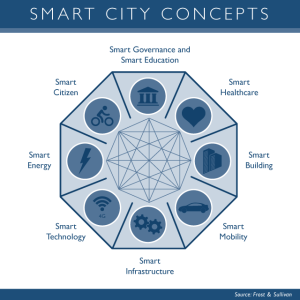
Smart Cities — A $1.5 Trillion Market Opportunity
Sarwant Singh
Forbes, 19 June 2014
Mahatma Gandhi once said, “India is to be found not in its few cities, but in its 700,000 villages.” Though that may at one time have been true, it is no longer the case. With about 30 country dwellers moving lock, stock and barrel every minute from Indian villages to become city dwellers, not many villages will be left in India by end of this century.

Towards the end of the last decade, our planet achieved two remarkable feats. First, our human population crossed the seven billion mark and for the first time in history, 50 percent of the world’s population was living in urban areas. This is expected to accelerate to 60 percent before 2025, globally; with the Western, developed world reaching an 80 percent urbanization level during this time frame. Urbanization has become so important that it has elevated some cities, like Brussels, Seoul, Bogota, and many more, to be even more important than the countries themselves contributing to over 40 percent of the country’s GDP. Interestingly, the UK has already demonstrated its efforts in focusing on this Mega Trend of urbanization and city as growth hubs with the creation of a new ministry role called the “minister for cities.” This person is tasked with unlocking the economic potential of cities, thus giving them more empowerment and freedom to do so.
– – – – – – –
Of these [four existing business models], the open business model is expected to foster the most innovation due to the level of flexibility and scalability such platforms offer. This is where, the city planner allows any qualified company or business organization to build city infrastructure and provide city services. The city planner, however, will impose some regulatory obligations.
ROBERT STEELE: “True Cost Economics” is not a concept that will be found in this Frost & Sullivan endeavor. The report is thoughtful and useful, but it is also an example of what Dr. Russell Ackoff would call “doing the wrong things righter, instead of the right thing.” The average Smart phone puts 100,000 Chinese into lukemia wards and poisons Chinese water beyond belief. Multiply that times every “smart” device and you have the earth equivalent of multiple nuclear wars. The REAL $4 Trillion Opportunity lies with the five billion poor (many of whom are in slum cities that we cannot afford to turn into “smart cities” in the way Frost & Sullivan imagines). Their needs are diametrically opposite the fifty year model of waste and corruption that underpinis the “smart city” thinking of Frost & Sullivan. I would be very interested in seeing what these excellent well-intentioned minds could come up with if they combined true cost economics with a focus on the slum cities. The recent INTERVIEW: Nafeez Ahmed (The Guardian) and Robert Steele on Re-inventing Intelligence to Re-engineer Earth ably outlines my alternative perspective on this matter.
See Also:
PDF (18 Pages): Strategic Opportunity Analysis of the Global Smart City Market
SlideShare: Global Smart City Market
Review: The Fortune at the Bottom of the Pyramid [Updated 5tyh Anniversary Edition]



